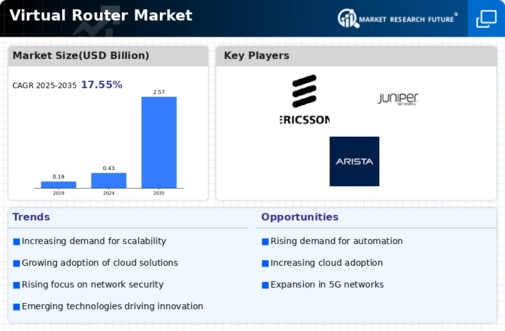Market Analysis
Virtual Router Market (Global, 2023)
Introduction
The Virtual Router Market is experiencing a transitional phase, driven by the growing demand for efficient and scalable network solutions in both the enterprise and the consumer segments. The digital transformation of organizations is bringing about a higher need for flexible and cost-effective network solutions. Virtual Routers, which leverage software-based routing to perform the routing functions, offer several advantages over traditional hardware-based routing solutions. These advantages include greater agility, simplified management, and improved resource scalability. Virtualization is further gaining momentum with the growing adoption of cloud services, the Internet of Things (IoT), and the rising focus on network security. The growing demand for Virtual Routers is expected to change the competitive landscape, driving innovation in the telecommunications and IT industries.
PESTLE Analysis
- Political
- In 2023, the virtual router market is subject to a tense political environment, mainly influenced by regulations on cyber security and data privacy. For example, the European Union's General Data Protection Regulation (GDPR) provides for fines of up to 20 million or 4 per cent of turnover for a non-compliant company, which has led many companies to invest in virtual routers to increase the security of their data. Also, the US government has allocated $ 1,9 billion for cyber security, which has led to the use of advanced network solutions such as virtual routers to protect sensitive data.
- Economic
- The virtual router market is expected to be characterized by a rising IT expenditure. The world's IT spending is expected to reach $45 billion by 2023. The demand for cloud services and remote working solutions is expected to drive the virtual router market growth. The average cost of virtual router deployment is estimated at $15,000, which makes it a viable option for small and medium-sized companies looking to enhance their network without significant capital expenditure.
- Social
- In 2023, the use of digital communications and work from home is still growing, and approximately one-third of the world's workforce is working at least part-time from home. The need for a reliable and secure network solution, including virtual routers, increases as companies try to maintain productivity and collaboration. Also, consumer awareness of privacy has increased, and more than 70 percent of consumers are worried about how their data is being handled. This also increases the need for secure virtual network solutions.
- Technological
- The virtual router market will be shaped by the integration of artificial intelligence and machine learning into the network solutions. The number of companies that are already using virtual routers that are based on AI to optimize the performance of the network and improve the security of the network is about 25 percent. Also, the advent of 5G will boost the demand for virtual routers that can handle higher speeds and lower latency. By 2023, the number of 5G subscribers is expected to reach one billion.
- Legal
- Legal factors affecting the virtual router market in 2023 include the strict compliance requirements with the data protection laws in various regions. For example, the Californian Consumer Protection Act imposes fines of up to $ 12,500 per infringement, which will force businesses to use virtual routers that ensure compliance with such regulations. Moreover, the increasing number of lawsuits resulting from data breaches will push companies to invest in more secure network solutions, thus further boosting the demand for virtual routers.
- Environmental
- In 2023 the Virtual Router Market is becoming increasingly concerned with the environment. The emphasis is on energy-saving and the preservation of natural resources. Data centres, which use virtual routers, are responsible for approximately 2% of global greenhouse gas emissions. Consequently, many companies are adopting energy-saving virtual routers, which consume 30 % less energy than conventional routers, thereby aligning themselves with the international sustainability goals and reducing their carbon footprint.
Porter's Five Forces
- Threat of New Entrants
- Barriers to entry are medium in the virtual router market because of the need for technical expertise and significant investment in equipment. The virtual router market is growing, but new entrants will have to overcome regulatory hurdles and build up a brand to compete effectively with established companies.
- Bargaining Power of Suppliers
- The suppliers in the virtual routing market have low bargaining power, because there are many technology companies and hardware manufacturers. The many suppliers give companies the opportunity to change suppliers easily, which limits the influence of a single supplier on the price and the conditions.
- Bargaining Power of Buyers
- The buyers in the virtual routing market have a high bargaining power due to the availability of alternatives and the low switching costs. Customers can easily compare the features and prices of the various suppliers, which puts more pressure on the suppliers to offer the best value and service.
- Threat of Substitutes
- The threat of substitutes in the virtual router market is moderate. Alternative network solutions such as physical routers and cloud-based network services can perform similar functions. However, the unique advantages of virtual routers, such as scalability and flexibility, help to mitigate this threat.
- Competitive Rivalry
- Competition is fierce in the Virtual Router Market. There are many players competing for a share of the market. The race to differentiate is intense, which means aggressive marketing strategies and price competition, which further intensifies the rivalry.
SWOT Analysis
Strengths
- Increased demand for flexible and scalable networking solutions.
- Cost-effective alternative to traditional hardware routers.
- Ability to support multiple protocols and services simultaneously.
Weaknesses
- Potential security vulnerabilities compared to physical routers.
- Dependence on stable internet connectivity for optimal performance.
- Limited awareness and understanding among non-technical users.
Opportunities
- Growing adoption of cloud computing and IoT devices.
- Expansion into emerging markets with increasing internet penetration.
- Integration with advanced technologies like AI and machine learning for enhanced performance.
Threats
- Intense competition from established networking hardware providers.
- Rapid technological changes leading to obsolescence.
- Regulatory challenges and compliance issues in different regions.
Summary
The Virtual Routers market will be characterized by its advantages in scalability, flexibility, and cost. In spite of these advantages, it will also have to contend with disadvantages such as security issues and lack of awareness. Opportunities are posed by the cloud and the Internet of Things. Threats will be posed by competition and regulatory issues. The strategic focus of the market will be on education, security, and the exploitation of newer technology.


















Leave a Comment